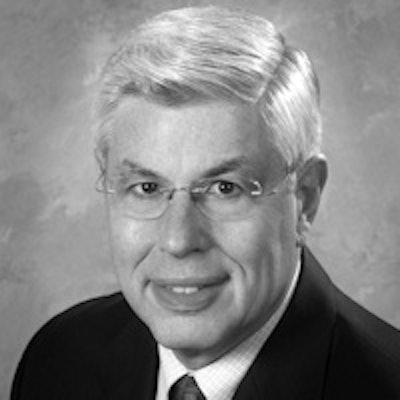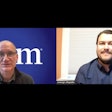
First, the good news: There are available jobs for the 1,200 or so U.S. radiology residents finishing their training. Now the bad news: These jobs may not be the first choice of many residents, according to a study published in the October issue of the Journal of the American College of Radiology.
"There seems to be a job for most people, but the market is a bit tighter than it's been in the past, and the available positions might not be what residents initially want," lead author Dr. Edward Bluth, from the Ochsner Clinic Foundation in New Orleans, told AuntMinnie.com.
The numbers raise the question of whether there are too many radiology residents being trained relative to the overall flatness of the radiology industry, according to a commentary on the study published in the same issue.
 Dr. Edward Bluth from the Ochsner Clinic Foundation.
Dr. Edward Bluth from the Ochsner Clinic Foundation."The relatively depressed radiology job market, which promises to be flat over the next three years, suggests that we should reconsider, and possibly decrease, the number of radiology residency positions in the U.S.," wrote Dr. Carolyn Meltzer, from Emory University, and colleagues. "Perhaps we are training too many radiologists at a time when the imaging volume growth curve has flattened."
Workforce survey
These mixed findings are courtesy of the second annual workforce survey conducted by Bluth and colleagues under the auspices of the American College of Radiology (ACR) Commission on Human Resources. The team used the Practice of Radiology Environment Database (PRED) to identify 2,067 radiology practice leaders and asked each to complete an electronic survey. Practices in PRED represented 65% of all practicing radiologists in the U.S., according to the authors (JACR, October 2013, Vol. 10:10, pp. 750-756).
The survey asked participants to report the number of radiologists currently employed in their practice, the number hired in 2012, and the number they plan to hire in 2013 and 2016. It was sent out via email in January of this year; final data were received by March. The survey asked respondents to subdivide their departments between physicians primarily practicing general radiology and those hired to serve mainly as subspecialists, and to describe their organizational type.
Bluth's team received responses from 462 of the 2,067 practices surveyed, for a 22% participation rate, slightly lower than the 2012 rate of 25%. The majority of survey respondents were subspecialists (79%), and the most common subspecialty areas were general interventional radiology, neuroradiology, and body imaging.
The percentage of survey participants across various geographic regions was similar both to the overall makeup of ACR members and to 2012 results, with the largest percentage in the South (25%), followed by the West and Midwest (both 21%), the Mid-Atlantic (17%), the Southwest (9%), and New England (7%).
In terms of practice type, survey respondents reported the following:
- 54% were in private practice.
- 19% worked in academic university practices.
- 14% practiced in academic clinics.
- 10% were hospital employees.
- 1% were corporate employees.
- 1% worked in either the Veterans Affairs health system or the military.
The researchers projected that in the workforce 7% of radiologists are older than age 65, 22% are between 56 and 65, 32% are between 46 and 55, 29% are between 35 and 45, and 10% are younger than 35.
How many jobs?
Last year's survey results showed that 1,241 radiologists had been hired in 2011, and it estimated that 1,103 positions would be available in 2012. But the 2013 results showed that 1,407 radiologists were hired last year, with general interventional radiologists forming the largest group (15.1%).
Bluth's team estimated that 1,526 jobs will be available in 2013 and 1,434 in 2016. There was no statistically significant difference between the actual 2012 results and projected 2013 job availability, so the researchers expect the market to remain flat this year, and they anticipate the trend will continue until 2016. Most job opportunities will be in private practice, followed by academic universities; in terms of geographic area, more jobs will be in the South, while the least availability will be in the Northeast.
Ironically, the survey showed a considerable need for general radiologists, but most new hires will be subspecialists.
"We expect that 2013 will bring more opportunities for general radiologists, breast imagers, neuroradiologists, teleradiologists, women's imagers, chest imagers, MRI specialists, and interventional neuroradiologists ... with a decrease in the hiring of body imagers, pediatric subspecialists, and those focusing on emergency/trauma, nuclear medicine, and informatics," the team wrote.
Workforce needs could change, depending on the retirement rates of older radiologists, which are influenced by the economy, individual finances, and personal health issues, according to Bluth and colleagues.
"As our survey demonstrates, 7% of the workforce (more than 2,000 individuals) is over the age of 65, and 22% is between the ages of 56 and 65," they wrote. "These figures indicate that more than 8,700 physicians are considering retirement or reducing their workloads."
The question of whether the right number of radiologists are being trained is important to consider, but with care -- since the long lag time needed to train radiologists requires sensitivity to the consequences of reacting to small shifts in supply and demand, Meltzer and colleagues wrote (pp. 757-759).
"Given the complexity of current variables and the trends that will influence both the demand for clinical imaging procedures and the number of practicing radiologists over the next five to 10 years, we advise maintaining the present number of diagnostic radiology residency slots," they wrote. "However, it will be essential to modify our training practices to include key skills for leading the transition from volume-based to value-based imaging."
For residents finishing their training now, Bluth said he would tell them to follow their interest, despite the uncertainty.
"Radiology is a wonderful field and continues to lead the way in technological advances," he told AuntMinnie.com. "If you like radiology, you should do it and not allow economics to influence your decision. There will be jobs -- even if you have to be patient for a while before you land your ideal position."



















